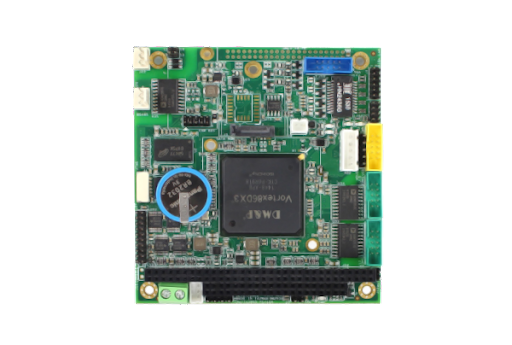Many embedded and H2M panel PCs, IT gateways such as routers and managed switches. Most mobile devices including tablet PCs, handhelds or smartphones use processors based on the ARM or RISC architecture. It has numerous advantages such as low power consumption and fast processing of individual instructions. It also entails disadvantages such as the lack of compatibility with programs and applications for servers, desktop PCs, and laptops or lower performance. The Vortex86 CPU series offers an alternative optimized for embedded PC and mobile devices, which allows the use of x86 processors and their interfaces in demanding environments.

Vortex86 - efficient, versatile SoC processors with x86 architecture
The development of the Vortex86 series goes back to the 90s of the last century and has since then successfully competed in the embedded PC and devices segment with global market leaders such as Intel or AMD. It is a system-on-a-chip (SoC) that concentrates other important components such as controllers for networking and the I/O into a minimal space in addition to the primary CPU. The Vortex86 family now includes an extensive selection of processors, ranging from the proven classic Vortex86SX with single core and 300 MHz for headless devices without graphics to the dual core Vortex86DX3 with support for 2 GB DDR3 RAM and Microsoft Windows or Linux as the operating system.
More innovation and efficiency through a homogeneous IT environment
Although weighty arguments speak for the use of processors of the ARM or RISC architecture in certain environments, their disadvantages repeatedly prove to be a decisive obstacle in the speedy and efficient implementation of projects. The most serious shortcoming is the complete incompatibility with applications and the significantly poorer overall computing performance. These weaknesses can be avoided with Vortex86 CPUs, which allow the use of precompiled programs for servers and desktop PCs and thus make time-consuming development work such as emulation of end devices, cross-compiling and debugging in experimental or simulated process flows superfluous.
Extensive selection of hardware and peripheral devices
An important reason for the use of Vortex86 processors is the broad support for additional hardware, which results from the use of interfaces and standards such as SATA, PCI 32 bit and Express, USB or Fast Ethernet for the LAN. The problem with ARM and RISC is often not only the physical communication or the lack of controllers for SATA storage media, but also the lack of support from manufacturers. For example, they only provide drivers or open source code for compiling on other architectures in exceptional cases and often do not document functions and elementary programming steps at all or do so incompletely and inadequately.
Optimized for compatibility, performance and efficiency
The primary application of the Vortex86 CPU is in low-power embedded devices, mobile computers and flexible M2M or H2M interfaces with continuous operation 24/7/365. They therefore have an extremely efficient design with power consumption of less than 5 watts under full load to achieve optimum performance at minimum running costs under these conditions. For use in time-critical tasks that require automated management or monitoring of processes, a comprehensive selection of Real Time Operation Systems (RTOS) is available that can be adapted to individual conditions with little effort.
Practical applications: from smart vision to embedded PC
Due to its compact, robust and universal design, Vortex86 processors are used in many areas. As a functional SoC chip, for example, it enables image processing in cameras for digital surveillance as well as use as a CPU and GPU for kiosk PCs, digital signage or point-of-sales (PoS). In addition, the Vortex86DX3 is one of the most popular processors for low-power CPU boards in modular PC/104 systems.

